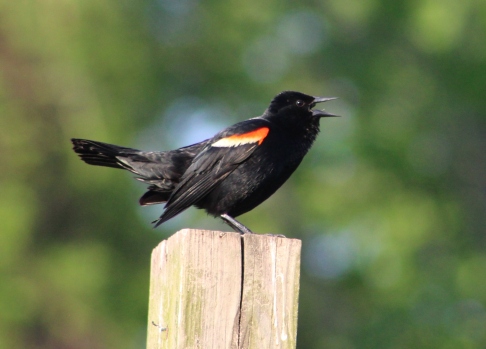Last week I enjoyed writing about the Wintertime Waterfowl in my area so much that I decided to do another Waterfowl Wednesday! (I am a waterfowl enthusiast after all! :-p).Today we’re going to learn about a species that is a newer bird for me: the Common Merganser. I saw my first Common Merganser on Sunday for Day 3 of the Great Backyard Bird Count. I thought it would be a great chance to learn about this interesting bird.

Common Merganser
Mergus Merganser
Description:
Males have white bodies, black upper backs, round green heads, and red bills. Females have gray bodies, cinnamon-colored heads with a crest, red bills, and white throats. Common Mergansers are slightly larger than Mallards, but smaller than geese. They tend to sit lower in the water like a loon would.

Range:
Breeds throughout Canada and the Northern United States. Winters in mid- to Southwestern United States into Northern Mexico.
Habitat:
Ponds and rivers while breeding, freshwater and occasionally saltwater in winter
Food:
Mainly fish. Common Mergansers will also eat invertebrates, small mammals, plants, frogs, and other birds. They can dive up to 13 ft to retrieve food, and sometimes dive deeper in the winter.
Breeding and Nesting Behavior:
Common Mergansers will have 1 brood (family) a year, with 6-13 eggs per clutch (number of eggs produced at a single time). They nest in tree cavities or nest boxes. Females incubate their eggs for about a month. Sometimes females will lay eggs in another Merganser’s nest, including other species of Mergansers. Once the eggs hatch the chicks will leave the cavity within a day or two and join their mother in the water. Picture this: flightless little chicks skydiving from the nest cavity to the forest floor! The mother will protect them, but she doesn’t feed them like a robin or hawk would feed their chicks pieces of food. The chicks will feed themselves while practicing swimming and diving.

Sounds:
Common Mergansers are usually silent. Females with make a frog-like gruk calls to the male and high cro cro cro sounds to her chicks. Males may give bell-like sounds while courting females.
Fun Facts:
- Common Mergansers are the largest of the 3 species of mergansers in North America (Hooded and Red-breasted are the 2 other species).
- Common Mergansers spend a lot of time floating around in open water on the surface. They sometimes sleep while floating around.
- Nicknames for Commons include “sawbill” and “goosander”
- Common Mergansers have teeth-like projections that help them hold onto slippery fish.
- Sometimes gulls will hang around with Common Mergansers and wait until they emerge from diving to try to steal fish. (This would explain why there were gulls hanging out with the male Merganser I saw at Forsythe).

See the gull watching our male Merganser? There were a few others hanging around as well.
Have you every seen a Common Merganser? We will have a new species of waterfowl next Wednesday. In the meantime, check back here at BirdNation for more bird info!


7 thoughts on “Common Merganser: Waterfowl Wednesday”